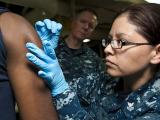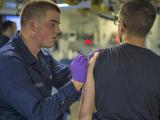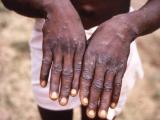Jun 9, 2003 (CIDRAP News) Thirty-three illness cases are under investigation in North America's first outbreak of monkeypox, 14 more than reported 2 days ago, with four cases confirmed so far, the Centers for Disease Control and Prevention (CDC) announced today.
"There are 33 cases of rash illness that are under investigation by the three midwestern states, Wisconsin, Indiana, and Illinois," said Steven Ostroff, MD, deputy director of the CDC's National Center for Infectious Diseases, during a telephone news briefing today. He said the cases include 18 in Wisconsin, 10 in Indiana, and 5 in Illinois.
"We've identified the presence of virus in four individuals," pointing to a "definitive diagnosis of monkeypox," Ostroff said. He said it seems very likely that "a substantial proportion" of the other cases will be confirmed, because the patients' signs and symptoms are very suggestive of the disease.
No deaths have been reported in the outbreak, Ostroff said. Seven of the 33 case-patients required hospital treatment, and six remained hospitalized today, he said.
Human monkeypox is a rare disease that occurs primarily in the rainforest countries of central and west Africa and has never before been seen in the Western hemisphere, according to the CDC. The illness clinically resembles smallpox but is less infectious and less lethal. The infection is believed to have spread to humans from pet prairie dogs, which may have caught it from a Gambian giant rat at a northern Illinois animal distributor's establishment.
"We do know that all of the individuals at this point are persons who have had direct contact with prairie dogs or, in one case, an ill rabbit that was in contact with prairie dogs," Ostroff said. "There is no evidence of person-to-person transmission at this point." He also said some of the patients were bitten by prairie dogs, but others seem to have caught the infection just by handling the animals.
Six patients in the outbreak are veterinarians or veterinary clinic workers, while three or four are pet shop workers, according to Ostroff. The rest are family members of prairie dog owners. Most of the patients have had fever and a rash characteristic of diseases like monkeypox, he reported. More than half have had respiratory symptoms as well.
The CDC reported previously that smallpox vaccine has been known to reduce the risk of monkeypox in previously vaccinated people in Africa. Ostroff said today he doesn't know whether smallpox vaccination after exposure to monkeypox would be protective, but the CDC is discussing that question with its Advisory Committee on Immunization Practices.
Ostroff said the risk of exposure to monkeypox is probably "remote" for people other than veterinary clinic and pet shop personnel and people who have bought or handled prairie dogs. "For the average person, I wouldn't necessarily be concerned about exposure to monkeypox," he said.
In announcing the outbreak Jun 7, the CDC said the illness usually began with fever, headache, myalgia, chills, and drenching sweats, and about a third of the patients had a nonproductive cough. The early symptoms were followed within 1 to 10 days by a rash that eventually crusted over. The incubation period was put at about 12 days.
Although the first cases in the outbreak showed up in early May, the CDC didn't learn of the situation until last Wednesday, Jun 4, Ostroff reported. "We are very interested in looking into the precise details of what information may have been available" earlier, he said in response to questions about the chronology of the outbreak and response. Later he added, "I think it's a little bit premature to raise the alarm that maybe there were some missed opportunities here."
See also:
Previous CIDRAP News story on monkeypox outbreak
CDC's interim guidance for veterinarians and pet owners regarding monkeypox
http://www.cdc.gov/ncidod/monkeypox/animalguidance.htm

















